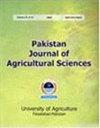棕榈仁饼的营养价值及其在肉鸡低质量日粮中的应用
IF 0.6
4区 农林科学
Q3 AGRICULTURE, MULTIDISCIPLINARY
引用次数: 0
摘要
本试验旨在评价棕榈仁饼(PKC)的营养价值,探讨其对肉鸡生长性能的影响。首先测定PKC的干物质(DM)消化率和代谢能(ME)。选择18日龄三黄肉仔鸡700只,随机分为5个处理,每处理7个重复,每个重复20只鸡。试验期在基础饲粮中不添加PKC (T0组)或添加2% (T1组)、4% (T2组)、6% (T3组)、8% (T4组)PKC。预试期5 d,试验期18 d。测定生长性能[平均日增重(ADG)、平均日采食量(ADFI)和料肉比(F/G)]。结果表明:PKC的DM、粗蛋白质(CP)、粗纤维(CF)、粗脂肪(EE)、粗灰分、钙(Ca)、磷(Pi)和总能(GE)含量分别为91.30%、15.87%、14.31%、10.41%、3.73%、0.34%、0.57%和18.28 MJ/kg。PKC中含有17种氨基酸(AA),总氨基酸含量为13.26%。PKC的DM表观消化率和DM真消化率分别为24.11%和28.73%。PKC表观代谢能(AME)和真代谢能(TME)分别为7.73 MJ/kg和8.41 MJ/kg。饲粮中添加PKC对肉鸡终末体重、平均日增重、平均日增重和料重比无显著影响,但PKC与平均日增重之间存在显著的线性关系(y=0.2006x+73.63, R2=0.8358, p=0.0298)。饲料成本随PKC添加量的增加而降低,T2组(4% PKC)、T3组(6% PKC)、T4组(8% PKC)的相对经济效益分别比对照组降低1.07%、0.89%、0.36%,仅2% PKC组的相对经济效益比对照组提高0.71%。由此可见,低品质饲粮中PKC添加量不超过8%对肉鸡生长性能没有影响,但从经济效益考虑,以2% PKC添加量为宜本文章由计算机程序翻译,如有差异,请以英文原文为准。
The nutritive value of palm kernel cake and its application in low quality diets of broiler chickens
The aim of this study was to evaluate the nutritive value of palm kernel cake (PKC) and to investigate its effect on growth performance of broiler chickens. Firstly, the dry matter (DM) digestibility, metabolic energy (ME) of PKC was determined. Secondly, a total of seven hundred 18-day-old Sanhuang broilers were randomly divided into 5 treatments with 7 replicates of 20 broilers each. Broilers were received basal diets without (T0 group) or with 2% (T1 group), 4% (T2 group), 6% (T3 group), 8% (T4 group) PKC supplementation throughout the trial period. The experiment lasted for 18 days after a five days prefeeding period. The growth performance [average daily gain (ADG), average daily feed intake (ADFI), and feed to meat ratio (F/G)] were measured. The results showed that the DM, crude protein (CP), crude fiber (CF), crude fat (EE), crude ash, calcium (Ca), phosphorus (Pi) and gross energy (GE) content of PKC was 91.30%, 15.87%, 14.31%, 10.41%, 3.73%, 0.34%, 0.57% and18.28 MJ/kg respectively. There are 17 kinds of amino acid (AA) in PKC, and had a total AA content of 13.26%. The apparent DM digestibility and true DM digestibility of PKC was 24.11% and 28.73%, respectively. The apparent metabolizable energy (AME) and true metabolizable energy (TME) of PKC was 7.73 MJ/kg and 8.41 MJ/kg, respectively. Dietary PKC supplementation had no effects on the final body weight (FBW), ADG, ADFI and F/G of broilers, while, there was a significant linear relationship between PKC and ADFI (y=0.2006x+73.63, R2=0.8358, p=0.0298). The feed cost were decreased with the increased of PKC supplementation, and the relative economic benefit in T2 group (4% PKC), T3 group (6% PKC), T4 group (8% PKC) was decreased by 1.07%, 0.89%, 0.36%, respectively, only the 2% PKC group increased the relative economic benefit by 0.71% compared with control group. In conclusion, the supplementation of PKC up to 8% in low quality diets did not affects the growth performance of broilers, but considering the economic benefit, it is advisable to add 2% PKC in the diet of broilers
求助全文
通过发布文献求助,成功后即可免费获取论文全文。
去求助
来源期刊

Pakistan Journal of Agricultural Sciences
AGRICULTURE, MULTIDISCIPLINARY-
CiteScore
1.80
自引率
25.00%
发文量
18
审稿时长
6-12 weeks
期刊介绍:
Pakistan Journal of Agricultural Sciences is published in English four times a year. The journal publishes original articles on all aspects of agriculture and allied fields.
 求助内容:
求助内容: 应助结果提醒方式:
应助结果提醒方式:


